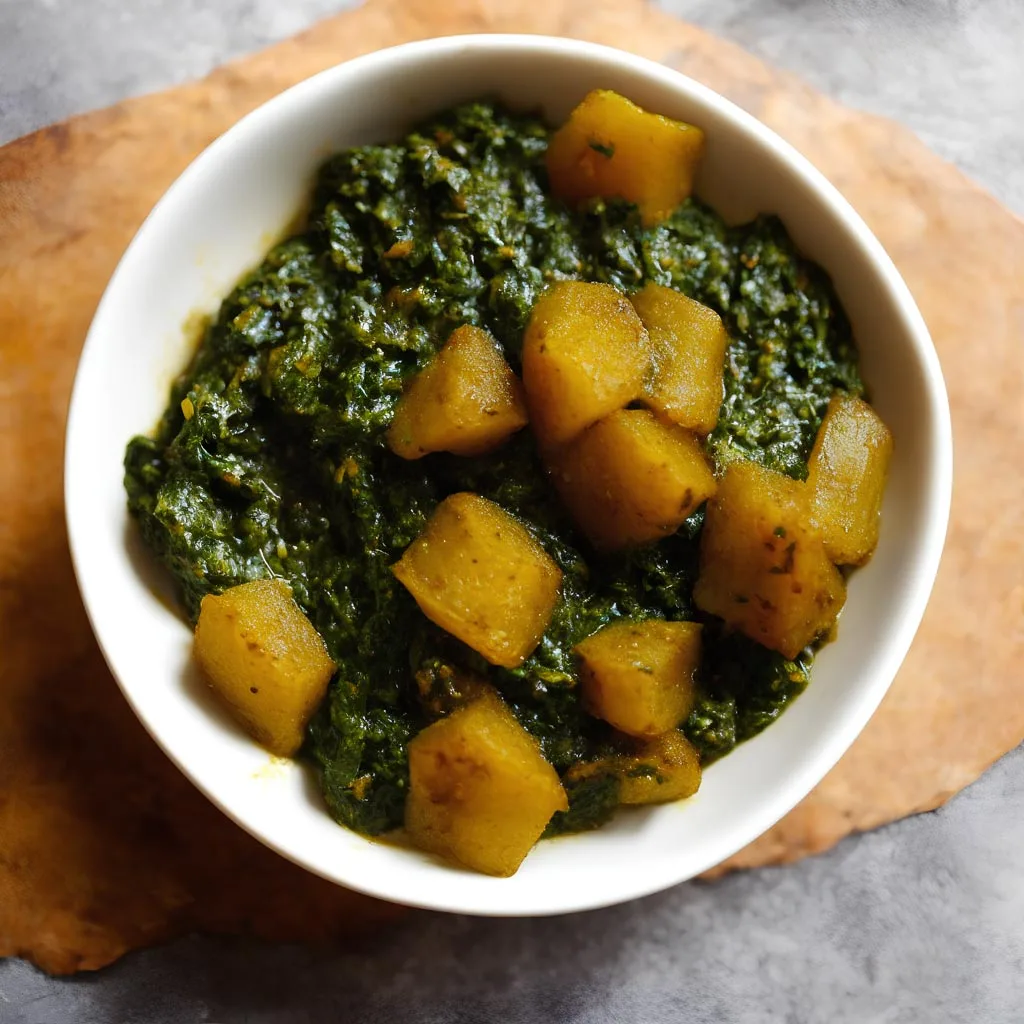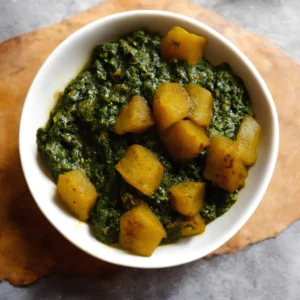
Saag Aloo is a classic North Indian dish that combines the earthy flavors of potatoes with the vibrant goodness of spinach and fenugreek.
Originating from the Punjab region, this dish has become a beloved staple in Indian households and is cherished for its simplicity yet rich taste. Despite its traditional roots, Saag Aloo is quite approachable for beginners in the kitchen, offering a delightful journey into the realm of Indian cuisine.
The name “Saag Aloo” itself reflects its essence; “saag” refers to leafy greens, typically spinach in this case, while “aloo” means potatoes. Together, these two ingredients form the heart of this dish, complemented by a medley of aromatic spices that elevate its flavor profile.
From the sizzle of cumin seeds to the warmth of garam masala, each component adds depth and character to the dish. While some may find Indian cooking intimidating, Saag Aloo breaks down barriers with its straightforward preparation and readily available ingredients.
With just a handful of spices and pantry staples, you can recreate the comforting flavors of this dish in your own kitchen. Whether served alongside fluffy naan bread or fragrant rice, Saag Aloo promises a satisfying meal that celebrates the beauty of simplicity.
Expert Tip: Add a squeeze of lemon juice at the end to brighten the flavors and balance the richness of the dish.
Potatoes: Potatoes provide a hearty base for the dish, offering a comforting texture and subtle sweetness that pairs perfectly with the robust flavors of the spices and greens.
Onion: Onions add a savory depth to the dish, enhancing its overall flavor profile and providing a fragrant base for the spices.
Garlic: Garlic lends its distinct aroma and flavor to the dish, contributing to its rich and aromatic character.
Ginger Paste: Ginger paste adds a warm, spicy note to the dish, complementing the other spices and adding a refreshing kick.
Green Chillies: Green chillies bring a subtle heat to the dish, balancing the flavors and adding a touch of brightness.
Cumin Seeds: Cumin seeds provide a nutty, earthy flavor and add a delightful crunch to the dish when toasted in oil.
Coriander Powder: Coriander powder adds a citrusy, slightly sweet flavor to the dish, enhancing its overall complexity.
Turmeric Powder: Turmeric powder imparts a vibrant yellow color to the dish and adds a warm, earthy flavor.
Garam Masala: Garam masala is a blend of aromatic spices that adds warmth and depth to the dish, tying all the flavors together.
Chilli Powder: Chilli powder brings a fiery kick to the dish, adding heat and intensity to the flavor profile.
Vegetable Oil: Vegetable oil is used for cooking and helps to coat the ingredients evenly, ensuring they cook to perfection.
Fenugreek: Fenugreek leaves, also known as methi, lend a distinct, slightly bitter flavor to the dish, balancing the sweetness of the potatoes and spinach.
Spinach: Spinach adds a vibrant green color and a mild, slightly sweet flavor to the dish, enriching it with essential nutrients.
Salt: Salt enhances the flavors of the dish, bringing out the natural sweetness of the ingredients and balancing the spices.
Expert Tip: For extra flavor, roast the cumin seeds in a dry pan before adding them to the dish.
Saag Aloo is a versatile dish that can be enjoyed in various ways. Here are some serving suggestions to elevate your dining experience:
Expert Tip: Experiment with different variations of spices and greens, such as adding fenugreek seeds or substituting spinach with kale for a unique twist.
Yes, you can substitute frozen spinach for fresh in this recipe. Simply thaw the spinach and squeeze out any excess water before adding it to the dish.
Peeling the potatoes is optional and depends on personal preference. You can leave the skins on for added texture and nutrients if desired.
Absolutely! Feel free to adjust the amount of green chillies and chilli powder according to your taste preferences. You can also omit the chillies altogether for a milder version.
Saag Aloo can be stored in an airtight container in the refrigerator for up to 3-4 days. Reheat gently on the stovetop or in the microwave before serving.
Yes, you can freeze Saag Aloo for longer storage. Allow it to cool completely, then transfer it to freezer-safe containers or bags. It can be stored in the freezer for up to 2-3 months. Thaw overnight in the refrigerator before reheating.
Here are some more recipes for you to enjoy! If you my recipes don’t forget to rate and leave a comment.
If you have any recipe suggestions, please do not hesitate to ask me. A great way to stay in contact with me is through Instagram, Facebook, Twitter and YouTube. Don’t forget to tag me @CookwithNabeela in your recipe photos!

Subscribe now to receive my latest recipes directly in your inbox. Stay up-to-date and never miss out!

I love to cook! I want to share with you my favourite, delicious family-friendly recipes. I want to inspire you to create fantastic food for your family every day.
Add your first comment to this post